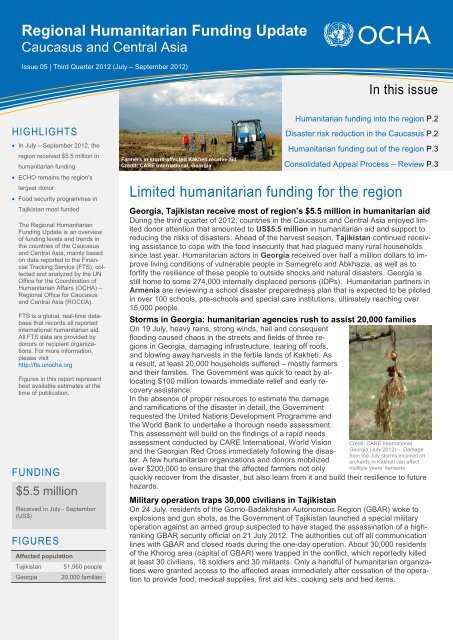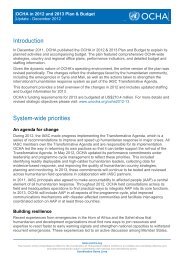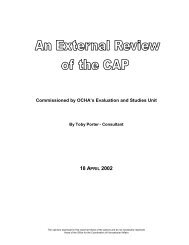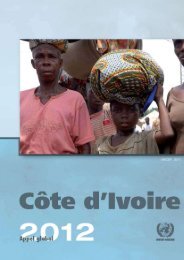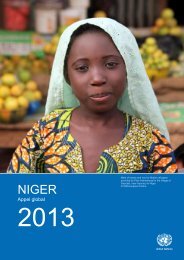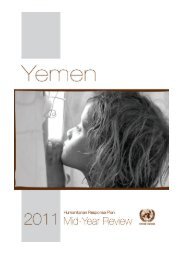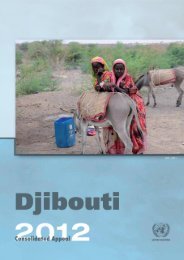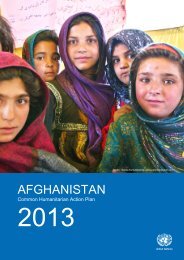BRIEFING KIT
BRIEFING KIT
BRIEFING KIT
- No tags were found...
You also want an ePaper? Increase the reach of your titles
YUMPU automatically turns print PDFs into web optimized ePapers that Google loves.
Regional Humanitarian Funding UpdateCaucasus and Central AsiaIssue 05 | Third Quarter 2012 (July – September 2012)In this issueHIGHLIGHTS In July – September 2012, theregion received $5.5 million inhumanitarian funding ECHO remains the region’slargest donor Food security programmes inTajikistan most fundedThe Regional HumanitarianFunding Update is an overviewof funding levels and trends inthe countries of the Caucasusand Central Asia, mainly basedon data reported to the FinancialTracking Service (FTS), collectedand analyzed by the UNOffice for the Coordination ofHumanitarian Affairs (OCHA) –Regional Office for Caucasusand Central Asia (ROCCA).FTS is a global, real-time databasethat records all reportedinternational humanitarian aid.All FTS data are provided bydonors or recipient organizations.For more information,please visithttp://fts.unocha.orgFigures in this report representbest available estimates at thetime of publication.FUNDING$5.5 millionReceived in July - September(US$)FIGURESAffected populationTajikistanGeorgia51,960 people20,000 familiesFarmers in storm-affected Kakheti receive aidCredit: CARE International, GeorgiaLimited humanitarian funding for the regionGeorgia, Tajikistan receive most of region’s $5.5 million in humanitarian aidDuring the third quarter of 2012, countries in the Caucasus and Central Asia enjoyed limiteddonor attention that amounted to US$5.5 million in humanitarian aid and support toreducing the risks of disasters. Ahead of the harvest season, Tajikistan continued receivingassistance to cope with the food insecurity that had plagued many rural householdssince last year. Humanitarian actors in Georgia received over half a million dollars to improveliving conditions of vulnerable people in Samegrelo and Abkhazia, as well as tofortify the resilience of these people to outside shocks and natural disasters. Georgia isstill home to some 274,000 internally displaced persons (IDPs). Humanitarian partners inArmenia are reviewing a school disaster preparedness plan that is expected to be pilotedin over 100 schools, pre-schools and special care institutions, ultimately reaching over15,000 people.Storms in Georgia: humanitarian agencies rush to assist 20,000 familiesOn 19 July, heavy rains, strong winds, hail and consequentflooding caused chaos in the streets and fields of three regionsin Georgia, damaging infrastructure, tearing off roofs,and blowing away harvests in the fertile lands of Kakheti. Asa result, at least 20,000 households suffered – mostly farmersand their families. The Government was quick to react by allocating$100 million towards immediate relief and early recoveryassistance.In the absence of proper resources to estimate the damageand ramifications of the disaster in detail, the Governmentrequested the United Nations Development Programme andthe World Bank to undertake a thorough needs assessment.This assessment will build on the findings of a rapid needsassessment conducted by CARE International, World Visionand the Georgian Red Cross immediately following the disaster.A few humanitarian organizations and donors mobilizedover $200,000 to ensure that the affected farmers not onlyHumanitarian funding into the region P.2Disaster risk reduction in the Caucasus P.2Humanitarian funding out of the region P.3Consolidated Appeal Process – Review P.3Credit: CARE InternationalGeorgia (July 2012) – Damagefrom the July storms incurred onorchards in Kakheti can affectmultiple years’ harvestsquickly recover from the disaster, but also learn from it and build their resilience to futurehazards.Military operation traps 30,000 civilians in TajikistanOn 24 July, residents of the Gorno-Badakhshan Autonomous Region (GBAR) woke toexplosions and gun shots, as the Government of Tajikistan launched a special militaryoperation against an armed group suspected to have staged the assassination of a highrankingGBAR security official on 21 July 2012. The authorities cut off all communicationlines with GBAR and closed roads during the one-day operation. About 30,000 residentsof the Khorog area (capital of GBAR) were trapped in the conflict, which reportedly killedat least 30 civilians, 18 soldiers and 30 militants. Only a handful of humanitarian organizationswere granted access to the affected areas immediately after cessation of the operationto provide food, medical supplies, first aid kits, cooking sets and bed items.


